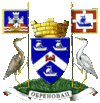Obrenovac
|
Obrenovac Обреновац |
||
|---|---|---|
| Suburban neighborhood and municipality | ||

Serbian Orthodox church
|
||
|
||
 Location of Obrenovac within the city of Belgrade |
||
 Location of the city of Belgrade within Serbia |
||
| Coordinates: 44°39′N 20°12′E / 44.650°N 20.200°ECoordinates: 44°39′N 20°12′E / 44.650°N 20.200°E | ||
| Country |
|
|
| District | Belgrade | |
| Settlements | 29 | |
| Government | ||
| • Mayor | Miroslav Čučković (URS) | |
| Area | ||
| • Municipality | 411 km2 (159 sq mi) | |
| Population (2011 census) | ||
| • Urban | 24,568 | |
| • Municipality | 71,419 | |
| Time zone | CET (UTC+1) | |
| • Summer (DST) | CEST (UTC+2) | |
| Postal code | 11500 | |
| Area code | +381 11 | |
| Car plates | BG | |
| Website | www |
|
Obrenovac (Serbian Cyrillic: Обреновац, pronounced [obrěːnoʋat͡s]) is a suburban neighborhood and one of 17 city municipalities which constitute the city of Belgrade, the capital of Serbia. According to the 2011 census results, the municipality has a population of 71,419 inhabitants, while the urban area has 24,568 inhabitants.
The largest Serbian thermal power plant TPP Nikola Tesla is located on the outskirts of the municipality. Obrenovac was also submerged and completely evacuated during the 2014 Southeast Europe floods.
Obrenovac is situated 30 km south-west of central Belgrade near bends of the river Sava to the north. The river Kolubara flows to the east of the town on its way to join the Sava.
Total land area of the municipality of Obrenovac is 411 km2 (159 sq mi). Apart from the town, it consists of the following villages:
Some of the neighborhoods in the town are Topolice, Rojkovac, Dudovi, Rvati, Muzička kolonija,Sljivice, Belo polje, Gaj and Stočnjak.
In the Middle Ages, the area was part of Serbian states. King of Srem Dragutin Nemanjić ruled it between 1282 and 1319, and established monasteries in Grabovac and Mislođin. In 1521, it was conquered by the Ottoman Empire, who ruled it for the next 300 years. Subsequently, it was site of numerous battles in frequent Ottoman–Habsburg wars and often changed hands. Austrian Regent of Serbia Charles Alexander, Duke of Württemberg built a summer house in nearby village of Stubline (then Neudorf). During a period of Austrian rule, between 1688. and 1717, the town was called Zweibrücken ('two bridges'), and during the Turkish rule it was called Palež ('arson'), possibly as a reference to frequent looting and fires it was subjected to.
...
Wikipedia

